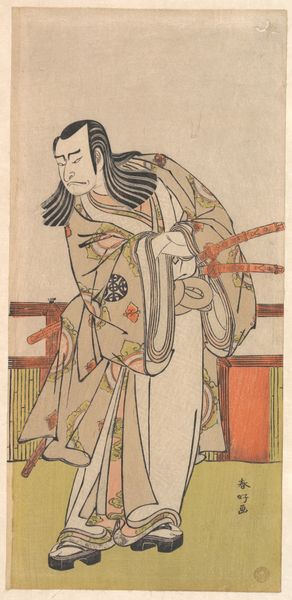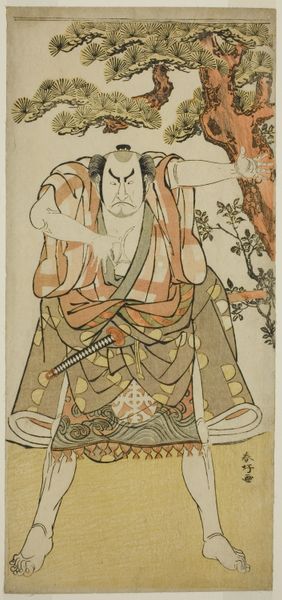
The sisters Matsukaze and Murasame on the shores of Suma c. 1790 - 1810
0:00
0:00
print, woodblock-print
#
portrait
# print
#
asian-art
#
landscape
#
ukiyo-e
#
figuration
#
woodblock-print
#
genre-painting
Copyright: Public Domain
Curator: This woodblock print, currently residing at The Art Institute of Chicago, is entitled "The sisters Matsukaze and Murasame on the shores of Suma," crafted around 1790-1810 by Utagawa Toyokuni I. Editor: There's such a wistful atmosphere emanating from this piece. The gentle lines and muted colors contribute to a feeling of subdued emotion, a silent story waiting to unfold. Curator: Indeed. The sisters, figures of classical Japanese literature and Noh theater, are here embodied in the Ukiyo-e style—'pictures of the floating world'. It’s worth remembering this piece emerges in a society with strict class hierarchy, which is then itself replaying a classical story, creating fascinating intersections of power, performance and the very notion of identity. Editor: That layering is what I find so compelling! Note the placement of the figures, too. The waves feel like they’re mirroring the inner turbulence. Water is, of course, frequently symbolic of the subconscious, the realm of emotion. It connects them not only to nature but to a deeper psychic landscape. Curator: Exactly. This work taps into shared cultural memory through these potent symbols. The pines, for instance, historically represent steadfastness and resilience, while these women in particular embody themes of abandonment and longing. The details of their garments—even the specific patterns—would carry layered significance. Editor: And the intimacy of genre-painting merges beautifully with traditional storytelling; such cultural encoding speaks volumes. We’re able to witness their internal worlds projected onto the landscape. This merging is also reflected in the figures' positioning relative to each other. Curator: It really demonstrates the intertwined nature of personal narratives within a larger societal framework, highlighting the universal themes of loss and resilience in the face of marginalization and precarity. It asks us who gets remembered, and on whose terms. Editor: A somber meditation. In exploring their cultural relevance, perhaps we may explore the depths of our shared cultural well.
Comments
No comments
Be the first to comment and join the conversation on the ultimate creative platform.













